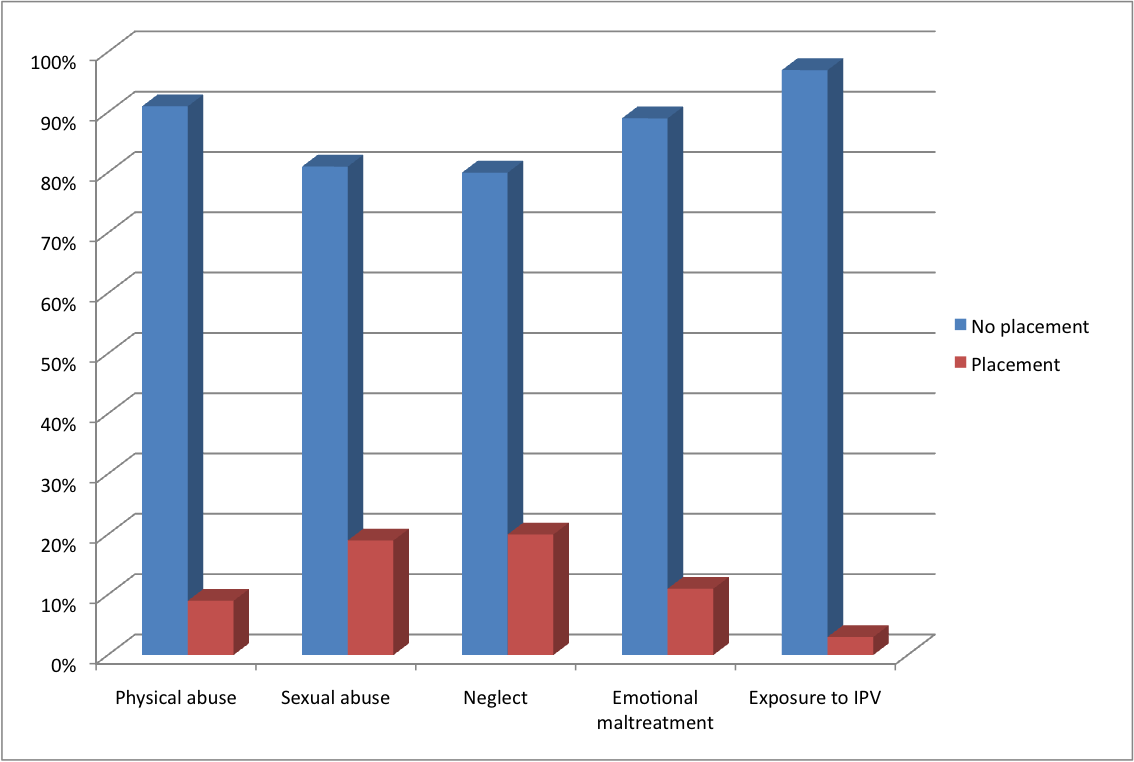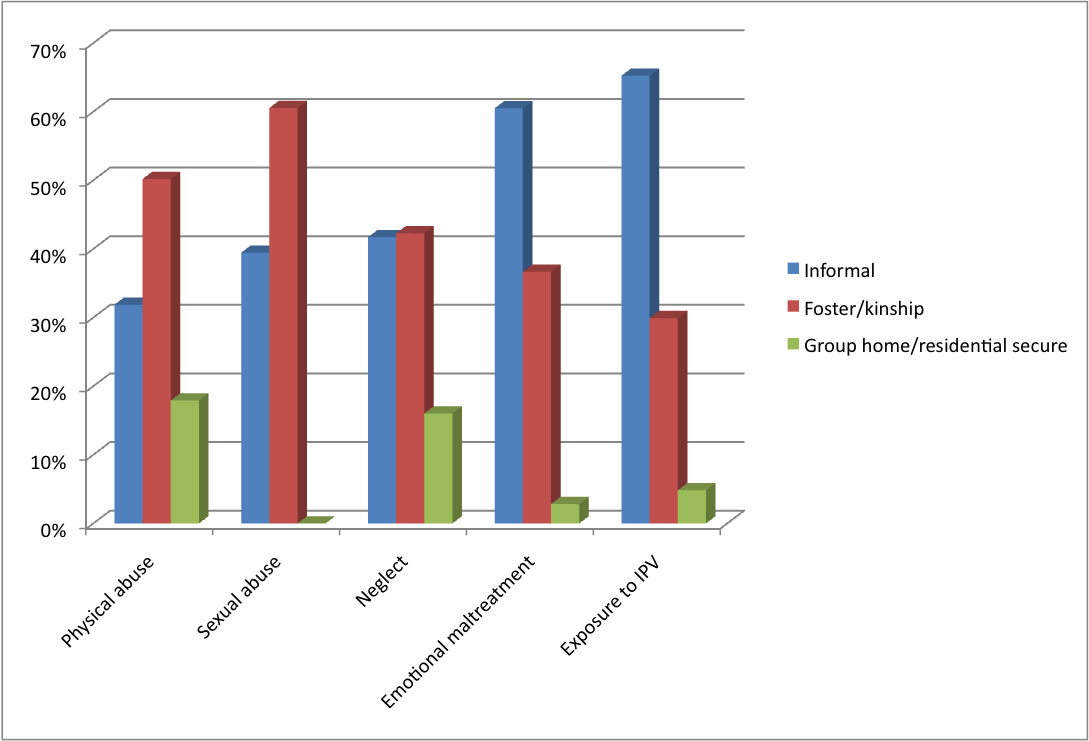Smith, C., Van Wert, M., Ma, J. & Fallon, B. (2012). OIS-2008: Rates of Out-of-Home Placement in Substantiated Maltreatment Investigations. Canadian Child Welfare Research Portal: Toronto, ON.
Introduction
The Ontario Incidence Study of Reported Child Abuse and Neglect, 2008 (OIS-2008) is the fourth provincial study to examine the incidence of reported child maltreatment and the characteristics of children and families investigated by child welfare authorities in Ontario. This fact sheet examines out-of-home placement among substantiated child maltreatment investigations, specifically examining placement across the five primary categories of maltreatment.
Background to the OIS-2008
From 1998 to 2003, the OIS found that rates of investigated maltreatment had doubled. This pattern may reflect changes in detection, reporting, and investigation practices rather than an increase in the number of children being abused and neglected. Four changes are particularly important to consider: increased reporting by professionals, increased reports of emotional maltreatment and exposure to intimate partner violence, more children investigated in each family, and increased substantiation rates. These changes are consistent with shifts in the context of Ontario child welfare.
Due to changes in investigation mandates and practices over the last 10 years, the OIS-2008 differed from previous cycles in that it tracked both risk-only investigations and maltreatment investigations. Risk-only investigations were those in which a specific past incident of maltreatment was not suspected or alleged to have occurred, but rather a constellation of factors lead to concerns that a child may be maltreated in the future (e.g., caregiver with a substance misuse issue).
Methodology
The OIS-2008 used a multi-stage sampling design to select a representative sample of 23 child welfare agencies in Ontario and then to select a sample of cases within these agencies. Information was collected directly from child protection workers on a representative sample of 7,471 child protection investigations conducted during a three-month sampling period in 2008. This sample was weighted to reflect provincial annual estimates.
For maltreatment investigations, information was collected regarding the primary form of maltreatment investigated as well as the level of substantiation for that maltreatment. Thirty-two forms of maltreatment were listed on the data collection instrument, and these were collapsed into five broad categories: physical abuse (e.g., hit with hand), sexual abuse (e.g., exploitation), neglect (e.g., educational neglect), emotional maltreatment (e.g., verbal abuse or belittling), and exposure to intimate partner violence (e.g., direct witness to physical violence). Workers listed the primary concern for the investigation, and could also list secondary and tertiary concerns.
For each form of maltreatment listed, workers assigned a level of substantiation. Maltreatment could be substantiated (i.e., balance of evidence indicated that the maltreatment had occurred), suspected (i.e., maltreatment could not be confirmed or ruled out), or unfounded (i.e., balance of evidence indicated that the maltreatment had not occurred).
Workers were also asked to indicate out-of-home placements that occurred at any time during the investigation. Workers specified types of placement, including informal kinship care, foster care (kinship and non-kinship), and group home and residential/secure treatment.
Out-of-Home Placements in Substantiated Child Maltreatment Investigations
In 2008, an estimated 128,749 maltreatment-related investigations were conducted in Ontario. Overall, it is estimated that out-of-home placement occurred for 13.39 children per 1,000 children age 0 to 15 in Ontario. Of all maltreatment-related investigations, an estimated 38,572 (30%) were substantiated maltreatment investigations. The largest proportion of substantiated investigations comprised of exposure to intimate partner violence (an estimated 15,087 investigations or 39%) and neglect (an estimated 11,894 investigations or 31%). In 21% of substantiated investigations (an estimated 7,936 investigations), the primary category of maltreatment identified was physical abuse. Emotional maltreatment was identified as the primary maltreatment form in 7% of the substantiated investigations (an estimated 2,884 investigations) and sexual abuse was identified as the primary category of maltreatment in 2% of substantiated investigations (an estimated 771 investigations).
Figure 1 presents out-of-home placements in substantiated investigations in Ontario in 2008, specifically examining placements across the primary categories of maltreatment. There were no placements in a large proportion of substantiated investigations across the categories of maltreatment. Approximately one-fifth of substantiated investigations of neglect (21% or an estimated 2,453 investigations) and sexual abuse (19% or an estimated 147 investigations) resulted in a change of residence for the child. Eleven percent of substantiated investigations of emotional maltreatment (an estimated 319 investigations) resulted in a change of residence for the child. Out-of-home placements were noted in 9% of substantiated investigations of physical abuse (an estimated 759 investigations) and in 3% of substantiated investigations of exposure to intimate partner violence (an estimated 518 investigations).
Figure 1: Out-of-home placement in substantiated child maltreatment investigations in Ontario in 2008

Figure 2 describes specific out-of-home placements in substantiated investigations, specifically examining placements across the primary categories of maltreatment among investigations conducted in Ontario in 2008. An estimated 2,453 substantiated investigations of neglect (21%) resulted in a change of residence for the child: 9% to informal kinship care (an estimated 1,023 investigations); 9% to foster care or kinship care (an estimated 1,037 investigations); and 3% to residential secure treatment or group homes (an estimated 393 investigations). Among substantiated investigations of sexual abuse, approximately 19% resulted in a change of residence for the child (an estimated 147 investigations): 8% to informal kinship care and 12% to foster care or kinship care.
Figure 2: Placement type in substantiated child maltreatment investigations in Ontario in 2008

An estimated 319 substantiated investigations of emotional maltreatment (11%) resulted in a change of residence for the child: 7% to informal kinship care (an estimated 193 investigations); 4% to foster care or kinship care (an estimated 117 investigations); and less than 1% to residential secure treatment or group homes. Of the substantiated investigations of physical abuse, 9% resulted in a change of residence for the child: 3% to informal kinship care (an estimated 242 investigations); 5% to foster care or kinship care (an estimated 381 investigations); and 2% to residential secure treatment or group homes (an estimated 136 investigations). Among substantiated investigations of exposure to intimate partner violence, 3% resulted in a change of residence for the child (an estimated 518 investigations): 2% to informal kinship care (an estimated 338 investigations); 1% to foster care or kinship care (an estimated 155 investigations); and less than 1% to residential secure treatment or group homes.
Overall, substantiated investigations of neglect and sexual abuse were the most likely to result in an out-of-home placement for the child, followed by substantiated investigations of emotional maltreatment and physical abuse. Substantiated investigations of exposure to intimate partner violence were least likely to result in a change of residence for the child.
Among substantiated cases of physical abuse and sexual abuse, foster/kinship placements were the most common type of placement. Among substantiated cases of emotional maltreatment and exposure to intimate partner violence, informal placements were the most common type of placement. In substantiated neglect cases, foster/kinship care and informal placements were equally as common. Group home/residential secure treatment facility placements were relatively uncommon across all maltreatment types.
Limitations of the OIS-2008
The OIS-2008 does not include information about unreported maltreatment, or cases that were only investigated by police. Reports that were made to child welfare authorities but screened out before they were investigated are not included, and reports on cases currently open at the time of case selection are also not included. The study does not track longer service events that occur beyond the initial investigation.
